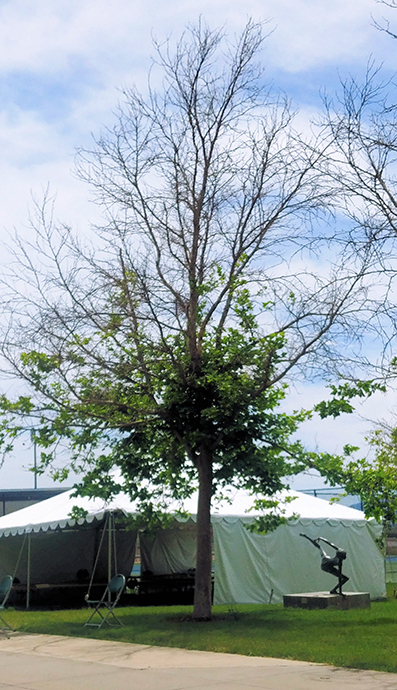Ask an Expert: Cool Wet Spring Causing Leaf Diseases
Leaf diseases have become a concern this spring because of the cool, wet weather, and rain provides an efficient way for fungal and bacterial spores to spread. Fungal disease symptoms generally include irregular brown, yellow or black spots on leaves. If left unchecked, branches can also become infected. As the season progresses, the spots may turn into holes in the leaves.
There are several strategies to prevent and manage leaf diseases:
1. Manage irrigation systems so they do not spray the foliage.
2. Irrigate during daylight hours where possible, when foliage can dry quickly.
3. Clean up infected leaf litter in the fall, and prune out heavily infected branches.
4. Consider the role plant genetics play in diseases, and avoid planting certain species such as sycamore (Platanus spp.), aspen, English hawthorn and peonies since they are highly susceptible to foliar diseases.
Most chemicals used to control plant diseases are best used as a preventative. For most diseases that have been seen this year, the correct timing for spraying is just before, or just as, the plant is leafing out.
As of mid-June, diseases still common along the Wasatch Front include fungal anthracnose in maple, oak and especially sycamore; powdery mildew on many trees and perennials like apple and peony; coryneum blight (shot-hole fungus) in stone fruits and related ornamentals such as purple leaf sand cherry; and fire blight bacteria in apples, pears and related ornamentals such as pyracantha, hawthorn, serviceberry and cotoneaster.
The best time to prevent anthracnose is in early spring with a registered fungicide. As drier weather sets in, fungicide sprays to control anthracnose or coryneum blight are less effective. Make spray applications when leaves start to emerge. Repeat applications may be necessary if the weather stays wet and cool. The optimal time to treat coryneum blight is just after petals fall from the flowers in the spring. Another excellent time is in autumn when about half the leaves have fallen.
Powdery mildew on trees and shrubs can be suppressed in early spring with a dormant oil application just before leaves emerge. After leaves are formed, either a summer-weight horticultural oil or neem oil can be sprayed according to the label as a continued preventative until dry weather sets in. Where there is risk for severe infection based on history, spraying in the spring, according to label directions, with a registered fungicide is often warranted.
Fire blight is bacterial and usually enters a plant through open flowers or through wounds from rain or insects. Infected wood turns black or dark brown in apples, looks burned and may form a shepherd’s hook on young branches where blossoms were. Once an infection occurs, pruning is the only way to remove it. Make pruning cuts into healthy wood 6 to 12 inches beyond where symptoms occur. Pruning tools must be disinfected with rubbing alcohol, hydrogen peroxide or disinfecting wipes after every cut. If fire blight is not pruned out, it will eventually kill the plant. Chemical sprays for fire blight are for prevention only and include agricultural antibiotics such as streptomycin or copper solutions. They must be sprayed when susceptible plants are flowering in the spring. Repeat applications may be needed during this time and will not harm pollinating insects.
It is also important to remember that not all discolored spots or holes in leaves are due to fungal or bacterial diseases. Nutrient deficiencies, such as severe iron deficiency, can cause leaves to get dead spots. Weather events, such as hailstorms and wind, account for most of the leaf damage on plant leaves.
For further information about anthracnose, visit the USU Extension Pest Lab website.
For further information about coryneum blight, see the USU Extension fact sheet.
For further information about powdery mildew, see the USU Extension fact sheet.
For further information about fire blight, see the USU Extension fact sheet.


 Utah 4-H & Youth
Utah 4-H & Youth